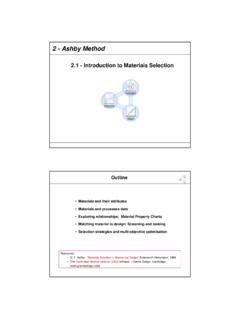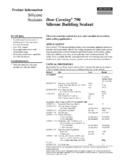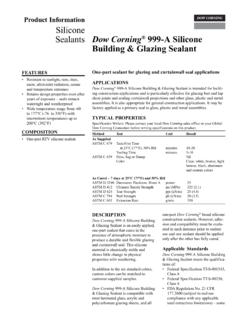Transcription of Handbook of Adhesives and Sealants - users.fs.cvut.cz
1 Chapter1An Introduction toAdhesive and IntroductionThis chapter provides an understanding of Adhesives and Sealants asa means for assembling and adding value to finished products. Theimportance and prominence that Adhesives and Sealants have as com-mercial products are highlighted. The multiple functions played byadhesives and Sealants are identified as are the critical proceduresrequired to achieve successful results. The advantages and disadvan-tages of using these materials are explained and compared to othermethods of definitions of common terms used in the adhesive and sealantindustries are provided in this chapter, and a glossary of terms ap-pears in Appendix A.
2 The processes employed by the manufacturersof Adhesives and Sealants and by their end-users are of information for further understanding and study are of-fered at the conclusion of this chapter and in Appendix this chapter, the reader will gain an appreciation of thecomplex processes related to Adhesives and Sealants and the multiplesciences that form their foundation. This chapter reveals why a multi-disciplined approach is necessary for the successful application of ad-hesives and Sealants . Most of the topics presented are again visitedin detail in later from Digital Engineering Library @ McGraw-Hill ( )Copyright 2004 The McGraw-Hill Companies.
3 All rights use is subject to the Terms of Use as given at the : Handbook of Adhesives and Sealants2 Chapter Fundamentals of Adhesives Importance of Adhesives andsealantsAdhesives and Sealants surround us in nature and in our daily businesses exist to develop, manufacture, and marketthese materials, and they are used within virtually every business andindustry. Applications abound from office post-it notes to automo-tive safety glass to footwear to aerospace structures to no-lick post-age stamps. Many products that we take for granted could never existif it were not for adhesive bonding or someone could determine the total value added to our economyby the relatively small amount of Adhesives and Sealants that areused, the result would be staggering.
4 Yet, with Adhesives and sealantsall around us, with applications extending back to at least biblicaltimes, and with many examples of outstanding adhesion in nature( , barnacles and ice on roads), why are there so many failures whenwe try to engineer the use of Adhesives or Sealants in practice? Whydoes it seem as if we must resort to trial and error, if not a bit of luckor magic? Examples of catastrophic disasters such as the 1986 Chal-lenger space shuttle sealant problem and the 1988 Aloha Airlines 737fuselage peeling apart in flight unfortunately also invade the historyof Adhesives and Sealants . Perhaps no other class of materials or tech-nology is so essential yet so ripe for potential Adhesives and Sealants industry is bolstered by thousands ofyears of trial and error.
5 This long history can be coupled with signif-icant additions to the fundamental supporting sciences and with thedevelopment of advanced materials and processes. Consequently, so-ciety has generally progressed to a point where we actually trust notonly our fortunes but also our lives to these materials. The study ofadhesives and Sealants and the sciences surrounding their applicationhas never been more DefinitionsAs any science that has progressed over the centuries, the science thatsupports Adhesives and Sealants has developed a jargon and languageof its own. Appendix A defines terms that are commonly used in theseindustries.
6 Important, basic terms necessary to develop a fundamentalunderstanding of how and why Adhesives and Sealants provide valueare given in this and Sealants are often made of similar materials, andthey are sometimes used in similar applications. These materials haveDownloaded from Digital Engineering Library @ McGraw-Hill ( )Copyright 2004 The McGraw-Hill Companies. All rights use is subject to the Terms of Use as given at the Introduction to adhesive and SealantsAn Introduction to Adhesives and Sealants 3comparable processing requirements and failure mechanisms, and thefundamentals of how they work are similar.
7 Therefore, Adhesives andsealants are often considered together, as they are in this , different specifications and test methods apply to adhesivesand Sealants , and most often they are designed to perform differentfunctions. Their definitions hint at these differing a substance capable of holding at least two surfaces to-gether in a strong and permanent a substance capable of attaching to at least two surfaces,thereby, filling the space between them to provide a barrier or pro-tective and Sealants are often considered together because theyboth adhere and seal; both must be resistant to their operating envi-ronments; and their properties are highly dependent on how they areapplied and processed.
8 Adhesives and Sealants also share several com-mon characteristics. They must behave as a liquid, at some time in the course of bondformation, in order to flow over andwet(make intimate contactwith) the adherends. They form surface attachment throughadhesion(the developmentof intermolecular forces). They must harden to carry sometimes continuous, sometimes vari-able load throughout their lives. They transfer and distribute load among the components in an as-sembly. They must fill gaps, cavities, and spaces. They must work with other components of the assembly to providea durable are chosen for their holding and bonding power.
9 They aregenerally materials having high shear and tensile a term generally used to define an adhesive whose strengthis critical to the success of the assembly. This term is usually reservedto describe Adhesives with high shear strength (in excess of 1,000pounds per square inch or psi) and good environmental of structural Adhesives are epoxy, thermosetting acrylic, andurethane systems. Structural Adhesives are usually expected to lastthe life of the product to which they are adhesivesare Adhesives with much lower strengthand permanence. They are generally used for temporary fastening orDownloaded from Digital Engineering Library @ McGraw-Hill ( )Copyright 2004 The McGraw-Hill Companies.
10 All rights use is subject to the Terms of Use as given at the Introduction to adhesive and Sealants4 Chapter OneFigure of cohesive and adhesive bond weak substrates. Examples of non-structural Adhesives arepressure sensitive films, wood glue, elastomers, and generally chosen for their ability to fill gaps, resistrelative movement of the substrates, and exclude or contain anothermaterial. They are generally lower in strength than Adhesives , buthave better flexibility. Common Sealants include urethanes, silicones,and acrylic Adhesives and Sealants function primarily by the property the attraction of two different substances re-sulting from intermolecular forcesbetweenthe substances.










